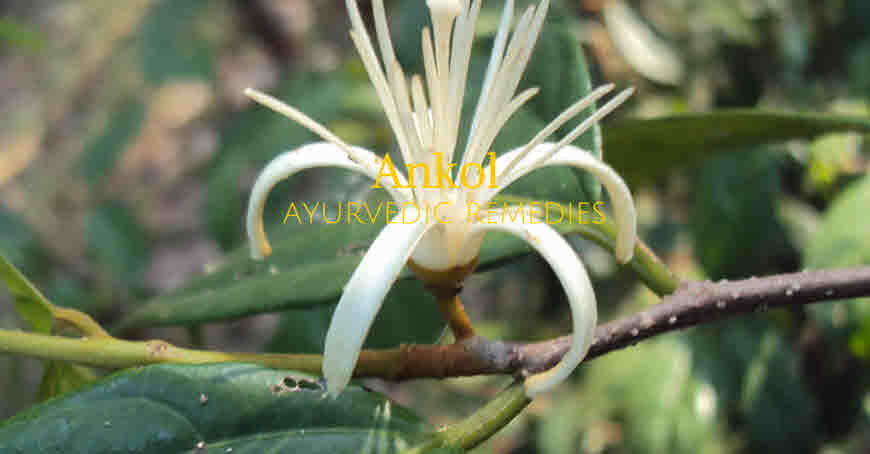Ankol tree is found throughout drier parts of India. It is a medicinal tree and its various parts are used in Ayurveda and Siddha system of medicine for the treatment of diseases. In Ayurveda, Ankol is the single medicinal herb that is used in the treatment of rabies. For this purpose the root bark is used both externally and internally. It is also used in the treatment of snake bite. Ankol tree is also used for the treatment of diarrhea, abdominal pain, ascites, skin diseases and fever.

The tree bark has laxative (loosen bowel), carminative (expels, cures flatulence) properties and is used in the treatment of abdominal pain, constipation and flatulence. Ankol fruits are sour and sweet in taste. The fruit pulp is useful in controlling phlegm in the chest, relieving constipation and in excessive menstrual bleeding.
Botanical name – Alangium salvifolium SYNONYM: Alangium lamarckii Thw.;
Family: Alangiaceae
Scientific Classification
- Kingdom: Plantae
- Unranked: Angiosperms
- Unranked: Eudicots
- Unranked: Asterids
- Order: Cornales
- Family: Cornaceae (Alangiaceae)
- Genus: Alangium
- Species: salvifolium
Vernacular names
- Ayurvedic: Ankola, Ankota, Tamraphal, Guptasneha, Dirghakelak
- BENGALI: Akar-kanta
- HINDI: Gujarati;Ankol
- KANNADA: Ankolima, Arinjil
- MALAYALAM: Azhinni
- ORIYA: Ankula
- ANDHRA PRADESH: Uduga chettu
- TAMIL: Azhinjil, Alangi
- TRADE NAME: Sage leaves alangium
- Type: Tree
- Part used: Root bark, bark, fruits, seeds, oil
- Propagation: by seeds
- Recommended dose of rootbark powder is 1-2 grams only. It must be taken in recommended doses only.
Description
Leaves alternate, petiolate, oblong/elliptic-lanceolate, chartaceous, 3-5 nerved at base, glabrous above, margin entire;flowers white, scented, in axillary clusters, pubescent outside;calyx tube cupular;adnate to the ovary;petals 10, linearly oblong, reflexed;stamens 20;fruits ovoid, 2-2 5 cm long;
Ankol tree Habitat
The tree is distributed in dry regions, in the plains and lower hills in India. It is also distributed in Africa, Sri Lanka, Indochina and China.
Medicinal uses of Ankola
The various parts of the tree exhibits medicinal properties and used as folk remedy for the treatment of diseases. Leaves have blood pressure lowering effect. Fruits are sour, acidic, cooling and laxative in action. Tree bark is sometimes used to induce vomiting. Root bark of the tree has an astringent, blood pressure lowering and fever reducing properties. Root bark is an antidote for poisoning and applied externally in case of acute rheumatism, leprosy and inflammatory patches.
Snake bite, rabies
Traditional remedy is to give one glass decoction of stem bark, once a day.
Ascites
Ascites is accumulation of fluid in the space between the lining of the abdomen and abdominal organs, causing abdominal swelling. It is caused due to high pressure in the blood vessels of the liver (portal hypertension) and low levels of a protein called albumin.
As a traditional remedy, the root powder of the tree is given in a dose of 1.5 to 3 grams.
Asthma
The roots of the tree are ground with lemon juice and taken in a dose of half teaspoon twice a day. This should be taken two hours before the meal.
Painful urination
Take 5 grams root and prepare a decoction by boiling in 400 ml water till volume reduces to one fourth. Drink this two times a day.
Diarrhoea, Dysentery
- For diarrhea, the fruits are useful. Eat ten grams of fruit pulp with honey, three times a day.
- Drink 3ml leaves juice with milk.
- Take root bark powder (1-2 g) with buttermilk.
Gout
Externally apply poultice of Ankol leaves.
Dengue fever
Cook three grams root powder and two gram dry ginger powder in Chawal Ka Mand (cooked rice water) and take 2-3 times a day.
Skin diseases
Prepare paste of the root bark and apply externally.
Side-effects/Warning
The leaves contain alkaloids which weakens force of muscular contractions. When leaves were given in a high doses to frog, the heart’s contractions were weaken and heart rate was slowed.
- The bark induces vomiting in large doses.
- Root bark has purgative effect.
- Always take in recommended doses.
So nice information.